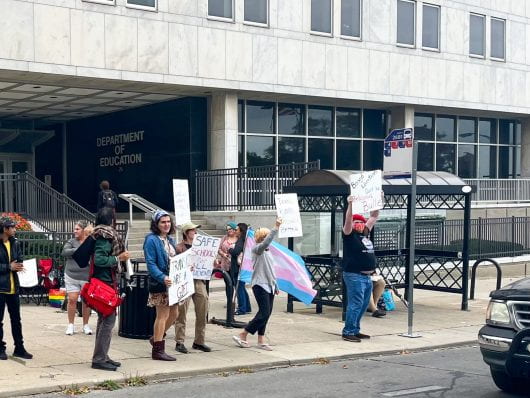
Brendan Shea, State of Ohio Board of Education member, sponsored a resolution Sept. 20 that would change the educational policy for LGBTQ+ students in Ohio. Credit: Reilly Ackerman | Lantern Reporter
State of Ohio Board of Education member Brendan Shea sponsored a resolution proposing to change the educational policy for LGBTQ+ students in Ohio. After hours of public commentary, the board failed to vote on or pass the resolution.
The resolution, which was first announced Sept. 20, will not move forward, and it will instead be sent to the executive committee after a 12-7 vote in the general assembly.
The resolution stated its opposition to the U.S. Department of Education Title IX regulations protecting gender identity and sexual orientation, and it would prohibit teaching about sexuality and gender. It would also ban those assigned male at birth from female-only facilities.
According to the resolution, Ohio schools would need to disclose information whenever a child claims a “discordant gender identity,” changes their pronouns, questions their gender identity or indicates any distress about their gender identity.
“The State Board of Education stands resolutely with parents, schools, and districts in rejecting harmful, coercive, and burdensome gender identity policies, procedures, and regulations,” the resolution stated.
Board member John Hagan from District 9 said he agreed with Shea’s proposal. While Hagan said he would change aspects of the resolution, he “definitely supports this resolution.”
“I think that we need to concentrate on the education of children,” Hagan said. “We are missing the mark on literacy and in math.”
The BOE hosted a public commentary session for the resolution Wednesday.
Colby Tarrh, a graduate student in the College of Social Work, shared his opposition to the resolution at the public session. Tarrh said he came out as gay at 14 years old and he think this proposal is harmful to LGBTQ+ youth based on his own experiences and academic research.
“I am not asking the board to affirm my identity. I am asking this board and the entire Ohio state government to leave its LGBTQ population in peace, stop attacking our ability to live safely in this state and offer us the decency and kindness that is supposed to be the experience of living in Ohio,” Tarrh said.
Tarrh said resolutions targeting LGBTQ+ children can contribute to higher suicide rates in his community. A 2022 Trevor Project survey of over 33,000 LGBTQ+ youth and young adults in the U.S. showed that nearly half of respondents have “seriously considered suicide,” and those who found their school to be affirming of their identity reported lower rates of attemping suicide.
Beth Murdoch, a board member of Hilliard City Schools, said she supported Shea’s resolution at Wednesday’s public session with amendments for parents to raise their child as they see fit without interference from schools.
Though she said she did not agree with some of Shea’s language in the resolution, Murdoch said she agreed with the resolution requiring schools to share information about children with their parents regarding gender identity.
Murdoch said in the public session she wishes to see public schools focus on the basics and distance themselves from politicized educational topics like anti-racism and sexual and gender identity because these issues “do not benefit Ohio students.”
“Let’s stop using schools as a training ground for activists for our favorite causes,” Murdoch said. “Let’s not pretend that schools have equal or greater rights than parents when it comes to raising their children, and let’s get back to educating our children.”
Murdoch said her opinions do not represent those of Hilliard City Schools’s administration or other employees.
During the BOE meeting Sept. 20, when Shea proposed the resolution, community members gathered to protest the resolution, such as the members of the Party for Socialism and Liberation, which shenby g — whose preferred name is lowercase and who uses they/them pronouns — said of which they are part.
“The masses of people who oppose bigotry, transphobia and attacks on children needed their voice to be heard outside of the parameters the board set up themselves,” g said.
g said the resolution is a “wake-up call” for the public to convey its struggles to ensure their rights are never questioned again.
“We believe this can only be possible through the power of the people, in a mass movement, and the construction of a new system — a socialist system,” g said.
University spokesperson Chris Booker said in an email the resolution will not impact LGBTQ+ individuals at Ohio State.
“[The] resolution from the state board oversees K-12 education,” Booker said. “The Ohio Department of Higher Education oversees higher education for the state.”
Ohio State provides measures to protect its transgender students, according to the university website, including gender-inclusive housing and restrooms and a preferred name policy allowing for name changes. The Student Life Student Health Insurance Benefit Plan also covers gender-affirming care — including counseling, hormone therapy and certain surgical procedures, according to the website.
A collection of LGBTQ+ resources at Ohio State and in Columbus can be found here.
This story was updated at 3:45 Thursday to fit shenby g’s pronouns.


